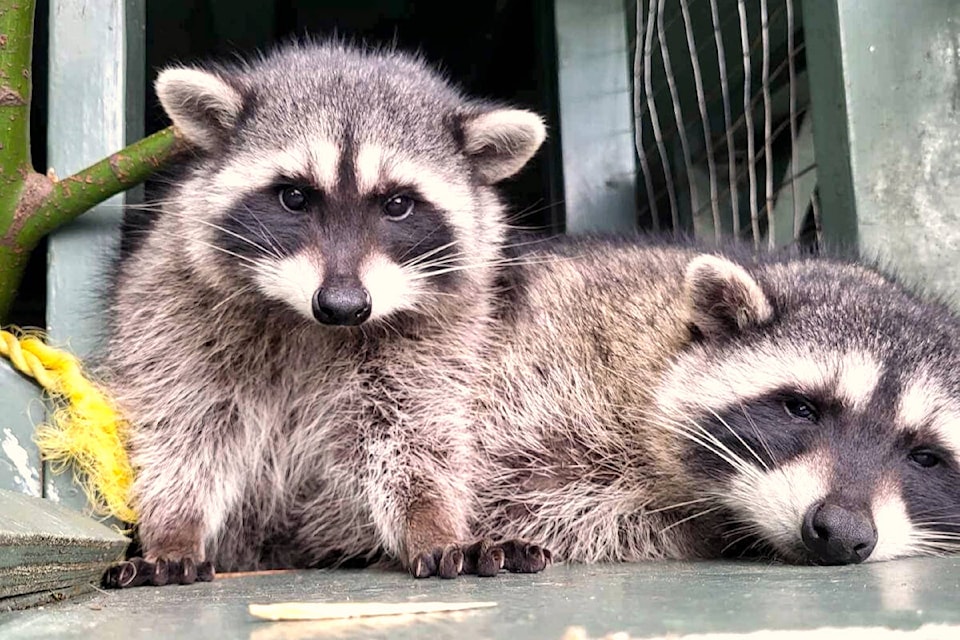As the start of baby season approaches for B.C.’s wildlife, Langley’s Critter Care Wildlife Society is sharing some tips and tricks to help people determine when an animal needs help.
Raccoons, squirrels, and bears are the most common animals the sanctuary is seeing, said senior wildlife supervisor Jenna Kuncewicz.
“Raccoons will seek warmth from buildings during cold weather and are fairly urban animals. People tend to mistake their natural behaviour for a cause for concern… There are many misconceptions surrounding raccoons, which could be part of why we intake so many,” she explained.
As a recent example, she points to the three raccoons that suffered severe injuries at a Mission property filled with traps. Two died, and the third was brought to Critter Care with severe damage to its paws.
READ MORE: 2 raccoons die from injuries in Mission traps, 1 survives at Langley wildlife sanctuary
Squirrels are prone to falling out of trees, dog attacks, being hit by cars, and can get stuck in vents, attics, or car engines when seeking warmth or during baby season, Kuncewicz said.
And bear numbers vary by year, but Critter Care has seen an uptick in numbers recently, and the society credits that due to human negligence.
Some mistakes people make include feeding the animal, taking an animal in to heal it themselves, and intervening before clarifying whether or not the animal is actually injured, sick, or orphaned, Kuncewicz said.
“People’s hearts are often in the right place, but the above interventions can harm the animal to a point of no return. We have had animals who people kept for weeks, causing their small infection to go septic.”
She added that feeding a baby animal the incorrect milk can harm them, and smelling, hearing, or being in close contact with humans or pets can severely stress the animal.
“Wildlife are very different from domestic animals and cannot withstand certain things that domestics can, and vice versa. Wildlife Rehabilitation is a very specialized field and it is important to consult with experts before doing anything,” Kuncewicz advised.
Each situation will be different, so she recommends staying near the wild animal and calling Critter Care to get appropriate advice for the specific circumstance.
On its website, Critter Care has some signs to watch for to determine when to call:
- Witnessing an animal struck by something
- Evidence of bleeding
- Signs of a broken limb
- Animal is shivering or seems disoriented
- Nearby deceased parent
Critter Care’s injured animals helpline can be reached at 604-530-2064.
Kuncewicz noted that babies, like fawns, are commonly left alone so the mother can forage for food. Unless the animal looks sick or injured or is left for more than 24-hours, its best practice to leave it where it is.
“If asked by a rehabber to check on a baby, touching or going near the baby animal will not cause mum to not return,” she added.
If a baby opossum falls off its mother’s back, Kuncewicz said to bring it to Critter Care or the nearest wildlife sanctuary as the mother will not notice she dropped it.
And if a baby beaver is seen outside of the dam without a parent nearby, that is also a concern.
“We always recommend leaving mum and babies alone until they move on themselves, as removal is not in their best interest,” Kuncewicz said.
She also noted that raccoons are opportunistic, so they will search for food at night or during the day.
Skunks only spray when they feel threatened or cornered, Kuncewicz said, so if one is nearby it doesn’t mean anyone will get sprayed.
“Skunks are extremely gentle creatures… they are also great for keeping rat and mice populations down.”
At home, people can keep their houses secure by patching up any holes where wildlife could get in.
“Check your yard before mowing the lawn or gardening, as rabbits make their warrens in long grass and other small creatures nest in plant pots or under bushes. Don’t cut down any trees or branches without checking for baby squirrels first,” Kuncewicz concluded.
IN OTHER NEWS: B.C.’s early January outdoor death rate close to last year’s despite cold snap
